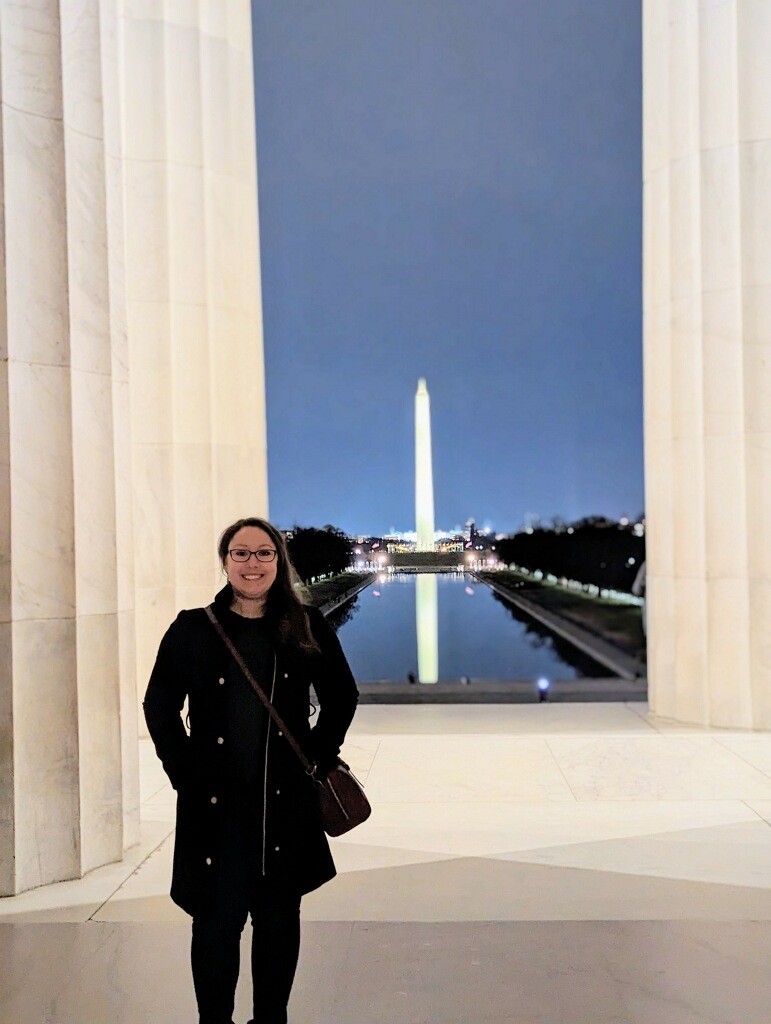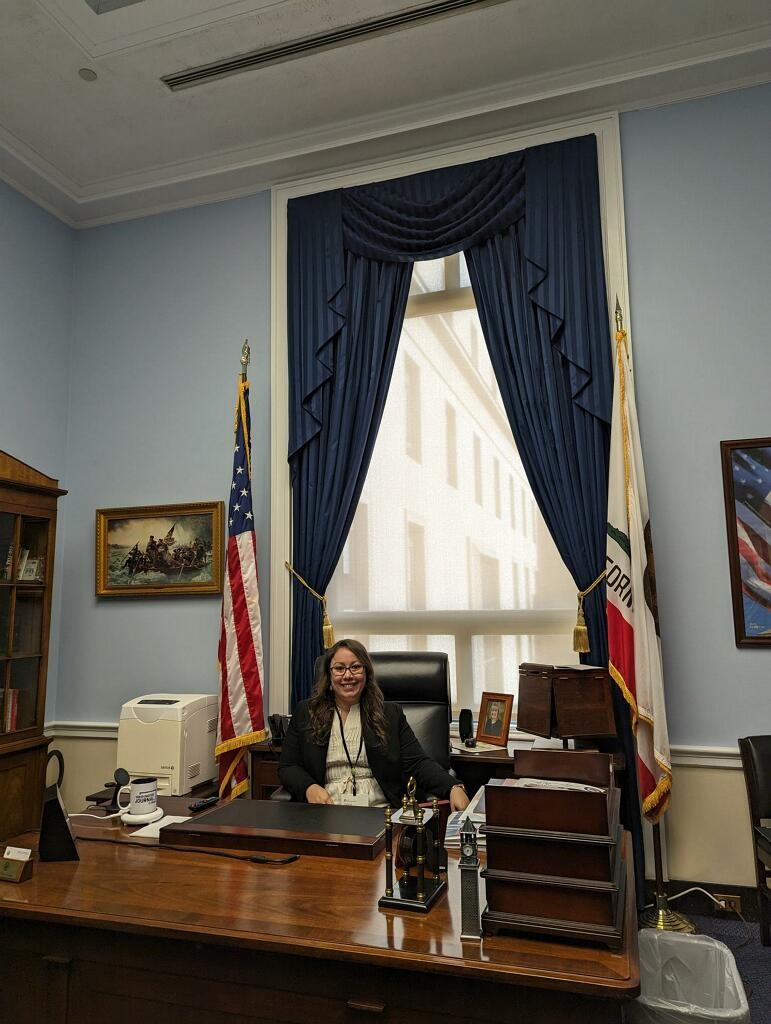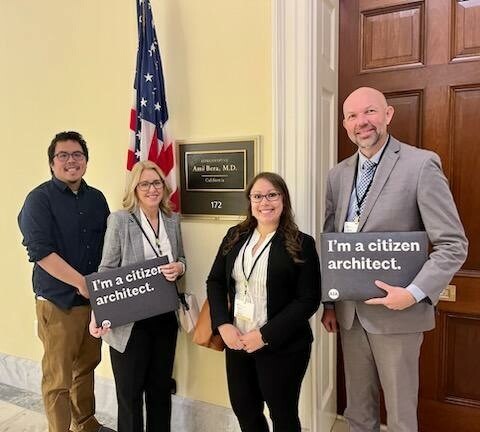by Felicia Reyes, Assoc. AIA, Associate Director
After two years of virtual gatherings, AIA’s Leadership Summit (formally Grassroots) returned to Washington, DC in February. For one-week Executive Directors, Vice Presidents, and Emerging Professional leaders from across the country gathered to immerse themselves in training, designed to help us become effective leaders in our chapters, firms, and communities.
Our Central Valley Chapter is one of the few components that brings Emerging Professionals (EP) to this event. As the EP representative this year, I was able to engage in elevated topics and conversations, garner insight from sage wisdom, and advocate for the inclusion of the EP voice. It was important to me to encourage other components to follow the AIACVs lead and include an EP representative at future summits.
As my colleague and fellow Board Member, Cody Carpino, AIA mentioned in last week’s NOTES, one of the biggest opportunities of the conference was our participation in Advocacy Day. This was a one-day event where summit attendees had scheduled appointments with our Congresspersons, Senate members, and their legislative staff. Our goal was to advocate on the behalf of two bills being introduced in the House and Senate. The first bill titled Democracy in Design Act, is in response to an Executive Order signed in 2020 that established classical architecture as the preferred design style for federal courthouses, agency headquarters, and federal buildings costing over $50 million. In 2021 an Executive Order was signed to revoke that mandate. This bill would codify the 1962 guiding principles for Federal Architecture that establish federal government neutrality from favoring or banning an architectural design style. The second bill titled Resilient AMERICA Act, would increase funding to FEMA’s BRIC program, provide funding to adopt and enforce the latest consensus-based building codes, establish a new Residential Retrofit and Resilience pilot program, and expands eligibility for FEMA’s Hazard Mitigation Assistance.
Participating in Advocacy Day was an opportunity that inspired me to reflect on the work done by the architectural community and the voice of our profession. We met with the Legislative staff who were engaging, inspired by our take on these issues and open to our ideas. For me as an EP, I was able to see how we as an organization can bring awareness to our representatives. I walked away feeling activated and ready to advocate on our behalf again.
One of the best takeaways I learned was that I can advocate at any time for an issue I am passionate about. The perception I had that there was a barrier between me as a newer voice and the decision makers was shattered through this experience. I now feel open to call and write my elected officials for an honest dialogue on issues I feel are important.
Building on the empowerment I felt from Advocacy Day, I was able to take part in a series of workshops designed to further our development as leaders in our industry. Mentorship is an area I am very passionate about both as a forever mentee, always learning, and as a mentor to my peers. Some key takeaways on this subject were: a mentor can help break down the barriers that your fear may establish; mentees do not need to adapt to your mentorship style, but need to be given the flexibility to be their own individuals; mentors may be confronted with risk and will need to encourage mentees to take a risk.
The last workshop I attended was hosted by Dr. Jermaine Davis “Leadership Development for Success.” Cody Carpino, our Chapter’s Vice President and I were both able to attend this session and found similar points that resonated with both of us. Some key takeaways I hope to implement as a leader were: be present and listen while you make space for others to share in an open and honest dialogue; Preparation + Opportunity = Success; when upset by a situation take the time to get back to your base line before engaging in further discussion; and practice the R.A.P. (Recognize, Acknowledge, and Praise) philosophy when working with others. I walked away remembering that we as leaders set the tone and that it is important to ask ourselves “Does my leadership lead to resistance, compliance, or commitment?”
After two years of virtual gatherings, AIA’s Leadership Summit (formally Grassroots) returned to Washington, DC in February. For one-week Executive Directors, Vice Presidents, and Emerging Professional leaders from across the country gathered to immerse themselves in training, designed to help us become effective leaders in our chapters, firms, and communities.
Our Central Valley Chapter is one of the few components that brings Emerging Professionals (EP) to this event. As the EP representative this year, I was able to engage in elevated topics and conversations, garner insight from sage wisdom, and advocate for the inclusion of the EP voice. It was important to me to encourage other components to follow the AIACVs lead and include an EP representative at future summits.
As my colleague and fellow Board Member, Cody Carpino, AIA mentioned in last week’s NOTES, one of the biggest opportunities of the conference was our participation in Advocacy Day. This was a one-day event where summit attendees had scheduled appointments with our Congresspersons, Senate members, and their legislative staff. Our goal was to advocate on the behalf of two bills being introduced in the House and Senate. The first bill titled Democracy in Design Act, is in response to an Executive Order signed in 2020 that established classical architecture as the preferred design style for federal courthouses, agency headquarters, and federal buildings costing over $50 million. In 2021 an Executive Order was signed to revoke that mandate. This bill would codify the 1962 guiding principles for Federal Architecture that establish federal government neutrality from favoring or banning an architectural design style. The second bill titled Resilient AMERICA Act, would increase funding to FEMA’s BRIC program, provide funding to adopt and enforce the latest consensus-based building codes, establish a new Residential Retrofit and Resilience pilot program, and expands eligibility for FEMA’s Hazard Mitigation Assistance.
Participating in Advocacy Day was an opportunity that inspired me to reflect on the work done by the architectural community and the voice of our profession. We met with the Legislative staff who were engaging, inspired by our take on these issues and open to our ideas. For me as an EP, I was able to see how we as an organization can bring awareness to our representatives. I walked away feeling activated and ready to advocate on our behalf again.
One of the best takeaways I learned was that I can advocate at any time for an issue I am passionate about. The perception I had that there was a barrier between me as a newer voice and the decision makers was shattered through this experience. I now feel open to call and write my elected officials for an honest dialogue on issues I feel are important.
Building on the empowerment I felt from Advocacy Day, I was able to take part in a series of workshops designed to further our development as leaders in our industry. Mentorship is an area I am very passionate about both as a forever mentee, always learning, and as a mentor to my peers. Some key takeaways on this subject were: a mentor can help break down the barriers that your fear may establish; mentees do not need to adapt to your mentorship style, but need to be given the flexibility to be their own individuals; mentors may be confronted with risk and will need to encourage mentees to take a risk.
The last workshop I attended was hosted by Dr. Jermaine Davis “Leadership Development for Success.” Cody Carpino, our Chapter’s Vice President and I were both able to attend this session and found similar points that resonated with both of us. Some key takeaways I hope to implement as a leader were: be present and listen while you make space for others to share in an open and honest dialogue; Preparation + Opportunity = Success; when upset by a situation take the time to get back to your base line before engaging in further discussion; and practice the R.A.P. (Recognize, Acknowledge, and Praise) philosophy when working with others. I walked away remembering that we as leaders set the tone and that it is important to ask ourselves “Does my leadership lead to resistance, compliance, or commitment?”
I was extremely honored to represent the AIACV chapter and our Emerging Professional members at the AIA Leadership Summit. My experience in Washington, DC was inspiring, eye opening, and empowering. The work that we do as a Chapter and with our counterparts on the national level is important and we need to continue to elevate our voice. I look forward to continuing my work as a leader in our field with my peers.



